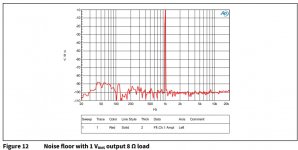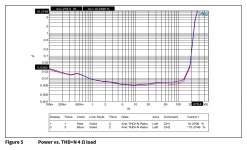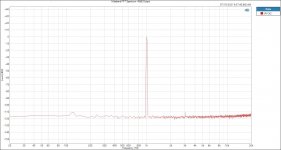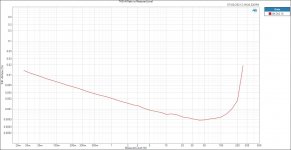Hello,
Trying to see how many people here would be interested in a group buy of my Starkrimson Ultra Amp modules.
$892 per pair -- 15% discount -- minimum 10 pairs of modules sold
$840 per pair -- 20% discount -- minimum 15 pairs of modules sold
$787 per pair -- 25% discount -- minimum 25 pairs of modules sold
Features:
Specifications:
Full test results here:
Starkrimson(R) Ultra Amplifier Modules -- 250/500W into 8/4ohm | Audio Science Review (ASR) Forum
Trying to see how many people here would be interested in a group buy of my Starkrimson Ultra Amp modules.
$892 per pair -- 15% discount -- minimum 10 pairs of modules sold
$840 per pair -- 20% discount -- minimum 15 pairs of modules sold
$787 per pair -- 25% discount -- minimum 25 pairs of modules sold
Features:
- Fully balanced from input to output (w/ differential input)
- Differential and single-ended audio inputs
- Extremely low noise and distortion
- Power output into 16Ω/8Ω/4Ω: 125W/250W/500W
- 2-ohm capable
- Overcurrent, overvoltage, and thermal protection
- 20A output current
Specifications:
- Gain (balanced input): 19.05dB
- Gain (single-ended input): 25.05dB
- Signal-to-Noise Ratio (SNR): 120dB (A-weighted)
- Input Impedance balanced/single-ended: 44k/22k
- Sensitivity (balanced input): 5Vin for 250W into 8Ω
- Sensitivity (single-ended input): 2.5Vin for 250W into 8Ω
- Damping Factor: >700 @ 1kHz
- Size: 4.95" (125.7mm) x 3.75" (95.3mm) x 1.45" (36.8mm)
- 6 x M3 / 4-40 mounting holes
- Required Power Supplies for Module (Hypex SMPS1200A100 provides all required voltages)
- +/-36V (+/-30 to 42.5V) - Amplifier Power Rails
- +15V (11 to 16V) - Mosfet Driver Supply - Referenced to -36V rail - 100mA minimum
- +/-12V (+/-10 to 22V) - Analog Supplies - 100mA per supply minimum
Full test results here:
Starkrimson(R) Ultra Amplifier Modules -- 250/500W into 8/4ohm | Audio Science Review (ASR) Forum
Attachments
-
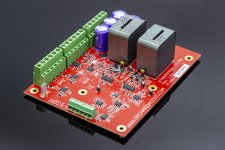 IMG_1589_1200px.jpg678.6 KB · Views: 366
IMG_1589_1200px.jpg678.6 KB · Views: 366 -
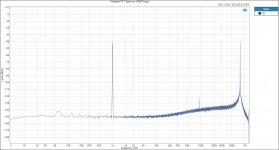 Wideband FFT Spectrum -40dB Output_4ohm.JPG106.6 KB · Views: 86
Wideband FFT Spectrum -40dB Output_4ohm.JPG106.6 KB · Views: 86 -
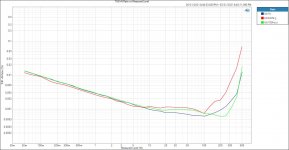 THD+N Ratio vs Measured Level_100_1k_6.67k_4ohm_.JPG110.1 KB · Views: 89
THD+N Ratio vs Measured Level_100_1k_6.67k_4ohm_.JPG110.1 KB · Views: 89 -
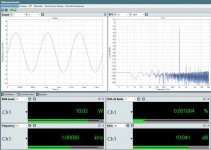 Bench_Mode_10W_4ohm.JPG214.4 KB · Views: 81
Bench_Mode_10W_4ohm.JPG214.4 KB · Views: 81 -
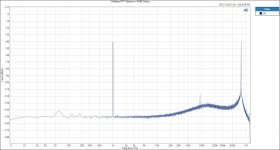 Wideband FFT Spectrum -40dB Output_8ohm.JPG106.5 KB · Views: 83
Wideband FFT Spectrum -40dB Output_8ohm.JPG106.5 KB · Views: 83 -
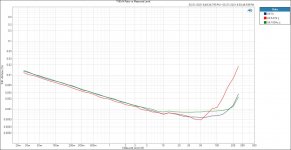 THD+N Ratio vs Measured Level_100_1k_6.67k_8ohm_.JPG109.7 KB · Views: 324
THD+N Ratio vs Measured Level_100_1k_6.67k_8ohm_.JPG109.7 KB · Views: 324 -
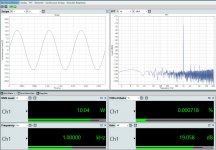 Bench_Mode_10W_8ohm.JPG212.1 KB · Views: 338
Bench_Mode_10W_8ohm.JPG212.1 KB · Views: 338 -
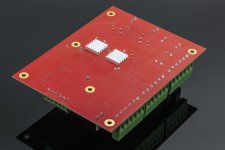 IMG_1592_1200px.jpg520.5 KB · Views: 347
IMG_1592_1200px.jpg520.5 KB · Views: 347 -
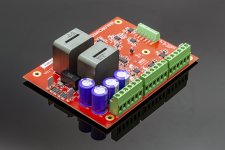 IMG_1590_1200px.jpg599.5 KB · Views: 353
IMG_1590_1200px.jpg599.5 KB · Views: 353 -
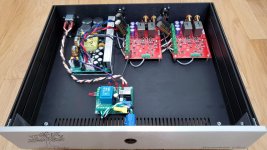 Ultra_Inside.jpg850.5 KB · Views: 290
Ultra_Inside.jpg850.5 KB · Views: 290
Last edited:
I have been reading and hearing good reports about the high sound quality/ low cost "bang for your buck" with various GaN technology and board suppliers.
Looking at your pictures and comparing / estimating the BOM cost to the commercially available eval boards and OEM pricing from these companies the BOM is under $120 in batches of 100 boards (50 pairs) ... Why are yours $400 per board?
Thanks.
Looking at your pictures and comparing / estimating the BOM cost to the commercially available eval boards and OEM pricing from these companies the BOM is under $120 in batches of 100 boards (50 pairs) ... Why are yours $400 per board?
Thanks.
I have been reading and hearing good reports about the high sound quality/ low cost "bang for your buck" with various GaN technology and board suppliers.
Looking at your pictures and comparing / estimating the BOM cost to the commercially available eval boards and OEM pricing from these companies the BOM is under $120 in batches of 100 boards (50 pairs) ... Why are yours $400 per board?
Thanks.
I am not sure how you get such a low number for the BOM it costs more than that.
You are also forgetting about the cost of the bare circuit boards which are not cheap because they use FR-408 material and have an ENIG finish.
In addition to the bare circuit board, there is also the cost of assembly, testing, and shipping.
I also run a business that requires; website fees, inventory fees, registration fees, taxes, and a slew of other items.
Thanks for your reply and I understand how the BOM (parts only) is added to the cost of the bare boards, then board population/assembly and testing costs.
I used to design telecom related PCB's for routers and switches and I have a friend who runs a medium CEM and he designs and builds over £5 million per year worth of PCB's for electronics clients...
Typically buying single eval boards ie this stereo GaN eval board is $480 EVAL_AUDAMP24 - Infineon Technologies
costs about 5 times the cost of an optimized board in batches of 100 and once you reach batches of 1,000 boards the cost is around 10% to 15% of the eval board.
I really like the GaN potential but I feel the value element is lacking at your price points.
I used to design telecom related PCB's for routers and switches and I have a friend who runs a medium CEM and he designs and builds over £5 million per year worth of PCB's for electronics clients...
Typically buying single eval boards ie this stereo GaN eval board is $480 EVAL_AUDAMP24 - Infineon Technologies
costs about 5 times the cost of an optimized board in batches of 100 and once you reach batches of 1,000 boards the cost is around 10% to 15% of the eval board.
I really like the GaN potential but I feel the value element is lacking at your price points.
Dev Kit Weekly: GaN Systems Audio Evaluation Bundle - YouTube
This STEREO flagship eval boards retails at $750 (the optional switch mode power supply is $250) with large redundant parts count for comprehensive test and Dev work costs $400 per channel ... An optimised balanced mono amplifier board will have a MUCH lower BOM / assembly cost.
Can you please shed some more light on why your small, lightly populated boards are $400 each?
This STEREO flagship eval boards retails at $750 (the optional switch mode power supply is $250) with large redundant parts count for comprehensive test and Dev work costs $400 per channel ... An optimised balanced mono amplifier board will have a MUCH lower BOM / assembly cost.
Can you please shed some more light on why your small, lightly populated boards are $400 each?
Compare the performance of the eval board you just mentioned to my amps.
Figure 5 and figure 12 from here:
EVAL_AUDAMP24 - Infineon Technologies
In some cases, the noise floor of my amps is 20dB lower and THD+N is also 20dB better.
Figure 5 and figure 12 from here:
EVAL_AUDAMP24 - Infineon Technologies
In some cases, the noise floor of my amps is 20dB lower and THD+N is also 20dB better.
Attachments
Both the eval board you mention have very much subpar performance to my modules. Please compare apples to apples.
Do you ask apple to justify the cost of the iPhone which sells for much larger profit margins than what I get on these modules?
I challenge you to do the same for less.
Do you ask apple to justify the cost of the iPhone which sells for much larger profit margins than what I get on these modules?
I challenge you to do the same for less.
I hope some of the members that purchased these from the other thread will star to weigh in soon:
500W (4ohm) GaN Class D Modules - Starkrimson Ultra
500W (4ohm) GaN Class D Modules - Starkrimson Ultra
Comparing a non optimised bench top development / eval board using low grade parts which is designed to act as a multi function test bed, to a a fully optimised / high part quality board I would have expected your boards to have a massive performance advantage across the full performance spectrum...Why such a relatively small difference?
I dont have the time to optimise one of the eval boards, (maybe other members do?) but its is now clear that it can be done for a far lower price than your $400 to $500 per channel.
I would buy in at $200 per channel and I think there are a lot of DIY audio guys who would be interested at that price?
I dont have the time to optimise one of the eval boards, (maybe other members do?) but its is now clear that it can be done for a far lower price than your $400 to $500 per channel.
I would buy in at $200 per channel and I think there are a lot of DIY audio guys who would be interested at that price?
Last edited:
Comparing a non optimised bench top development / eval board using low grade parts which is designed to act as a multi function test bed, to a a fully optimised / high part quality board I would have expected your boards to have a massive performance advantage across the full performance spectrum...Why such a relatively small difference?
I dont have the time to optimise one of the eval boards, (maybe other members do?) but its is now clear that it can be done for a far lower price than your $400 to $500 per channel.
I would buy in at $200 per channel and I think there are a lot of DIY audio guys who would be interested at that price?
How is it clear that it can be done at a lower price? Show me the proof! You yourself just agreed that the eval boards use low-grade parts. They are also manufactured in much larger quantities than what I manufacturer my modules at.
Secondly a 20dB (10x) performance difference is massive.
If you are willing to purchase 1000 of my modules I will be able to get you a much lower price. I do not even make them in 100 piece batches right now.
In a DIY Vendor market place all PCB product offerings must offer high value, the following points suggest that a small, low part density, high quality GaN based mono audio board can be made made and sold for under $200 per board, in batches of 100 are:
(1) As per my previous posts, the commercially available GaN development boards currently (this will drop rapidly over the next 12 months) retail for under $400 per channel. It has approx 10 times the part density and complexity of your optimised board.
(2) Using the industry standard production cost ratios for MOQ, a small, low part density eval board using commercial grade parts and designed just to amplify one channel, and produced in batches of 1,000 would retail at approx $30 to $50 per channel in batches of 100 approx $60 to $100 in batches of 100.
(3) Increasing part quality and using a high quality board would bring the cost back up to around $100 to $140 per board, depending how "audiophile" you want to brand the small BOM part count.
(4) Typical margins when selling PCB's to the DIY audio community are 35% and if you ask the established vendors on this site they are quite open about this fact.
(5) Therefore a fair and realistic retail price per board from a DIY Vendor would be approx $130 to $185.
(6) The above estimates, ratios and %'s hold true for the vast majority of consumer electronic PCB's.
DIY vendors products must be able to stand up to the above type of scrutiny, otherwise your sales wont even get into the tens never mind the fifty's...
(1) As per my previous posts, the commercially available GaN development boards currently (this will drop rapidly over the next 12 months) retail for under $400 per channel. It has approx 10 times the part density and complexity of your optimised board.
(2) Using the industry standard production cost ratios for MOQ, a small, low part density eval board using commercial grade parts and designed just to amplify one channel, and produced in batches of 1,000 would retail at approx $30 to $50 per channel in batches of 100 approx $60 to $100 in batches of 100.
(3) Increasing part quality and using a high quality board would bring the cost back up to around $100 to $140 per board, depending how "audiophile" you want to brand the small BOM part count.
(4) Typical margins when selling PCB's to the DIY audio community are 35% and if you ask the established vendors on this site they are quite open about this fact.
(5) Therefore a fair and realistic retail price per board from a DIY Vendor would be approx $130 to $185.
(6) The above estimates, ratios and %'s hold true for the vast majority of consumer electronic PCB's.
DIY vendors products must be able to stand up to the above type of scrutiny, otherwise your sales wont even get into the tens never mind the fifty's...
I am not sure where you are getting your prices but for example, my boards use:
4 x GS61008P-MR -- @ $10 each
2 x Sagami Inductor -- @ $15 each
Right there with no other costs, you are $70 per board.
My margins are in line with the industry standards.
4 x GS61008P-MR -- @ $10 each
2 x Sagami Inductor -- @ $15 each
Right there with no other costs, you are $70 per board.
My margins are in line with the industry standards.
Thanks, if you can post the BOM that would add clarity.
The two prices you quote are expensive even when buying in 10's to 50's, but regardless, there is a good discount at the 100 MOQ level.
From what you have said so far, you are saying the BOM is your main cost, it would have to be over $200 per board to justify your $400 to $500 prices.
Assembly will be 15% to 20% of the BOM cost in small (100 MOQ) runs.
The two prices you quote are expensive even when buying in 10's to 50's, but regardless, there is a good discount at the 100 MOQ level.
From what you have said so far, you are saying the BOM is your main cost, it would have to be over $200 per board to justify your $400 to $500 prices.
Assembly will be 15% to 20% of the BOM cost in small (100 MOQ) runs.
Thanks, if you can post the BOM that would add clarity.
The two prices you quote are expensive even when buying in 10's to 50's, but regardless, there is a good discount at the 100 MOQ level.
From what you have said so far, you are saying the BOM is your main cost, it would have to be over $200 per board to justify your $400 to $500 prices.
Assembly will be 15% to 20% of the BOM cost in small (100 MOQ) runs.
I can provide you with the BOM under NDA. If you want to see it please send me an email at leo@orchardaudio.com
Don´t forget that these EVMs are "sold" with regards to selling the ICs long-term.Typically buying single eval boards ie this stereo GaN eval board is $480
There is probably very little to no margin on these boards because that´s not their main business (=peanuts).
The "BOM" is often the smallest of all costs.
Development, quality control/inspection and measurement equipment, etc..
We sold amplifiers for 6000€ with a "BOM" of not even 1000€, not including labour, development (PCB, MMIC, 3D-EM-sim.), SMD-assembly, tuning, QC, various analyzers costing up to 0.5Meg$.
Do you find the Modulus amplifiers cheap?
Probably not but IMHO they have a very good price for what they are.
Buy a class-D-amp from aliexpress or similar if you want cheap but then please don´t complain (like many people here unfortunately do).
Not affiliated with any of these brands BTW.
Joe, selling a finished high end commercial amplifier is an entirely different business model from from selling PCB's on a DIY forum... None of your comparisons are, to use Orchards phrase " comparing apples with apples".
The BOM in any high end audio product will always be the smallest cost, with most high end amplifiers the fancy casework costs double the PCB BOM... Audiophiles pay for the looks... I have seen alloy flight cases used as packaging in a $6,000 audiophile amp which cost more than the Orchard BOM!
Back to the pricing of the GaN board... We have already established the BOM is by far and away the biggest cost of the Orchard product and the bare board costs is $10.
It would be great to have some more clarity on the rest of the BOM.
Thanks.
The BOM in any high end audio product will always be the smallest cost, with most high end amplifiers the fancy casework costs double the PCB BOM... Audiophiles pay for the looks... I have seen alloy flight cases used as packaging in a $6,000 audiophile amp which cost more than the Orchard BOM!
Back to the pricing of the GaN board... We have already established the BOM is by far and away the biggest cost of the Orchard product and the bare board costs is $10.
It would be great to have some more clarity on the rest of the BOM.
Thanks.
@Hydrogen Alex
What's your point here? If you don't want it or don't have the money to buy it, just don't! You don't need to bring down all of his engineering efforts. If he wants to make a million dollar profit on each board and you don't like it, don't buy, no one is forcing you to do so, right? I'm also non affiliated with Orchard but like every business, if you want it to continue, want to see new products being developed, then he needs to make some money, that's how business works...
Do
What's your point here? If you don't want it or don't have the money to buy it, just don't! You don't need to bring down all of his engineering efforts. If he wants to make a million dollar profit on each board and you don't like it, don't buy, no one is forcing you to do so, right? I'm also non affiliated with Orchard but like every business, if you want it to continue, want to see new products being developed, then he needs to make some money, that's how business works...
Do
We are talking about populated AND tested PCBs which makes these actually high-end-amplifier-modules rather than just PCBs.Joe, selling a finished high end commercial amplifier is an entirely different business model from from selling PCB's on a DIY forum
A PCB might be 10$ if you order enough, a populated PCB sure isn´t; especially so with expensive parts. If you would have to populate a couple parts manually it just gets more expensive with every hour. After QC/testing and packaging you probably end up with at least 2xcost(populated PCB+BOM).
And at the end, you can of course "round" that price&costs up just as you like.
If you have something very good, unique, whatever, you can take whatever you feel like.
A Jeff Rowland amplifier costs maybe >6000$ which could make high-end-amplifier-modules like orchardaudio´s and Neurochrome´s look cheap, no?
I´m sorry to spoil this group buy but I had to respond to questions coming up here. I find Hydrogen Alex questions rather naive and edging impudent.
How dare one put in question what a module is worth if you haven´t even tried, seen , measured such a product. And even then you just can´t question the price. If an engineer decides to want a margin of 300$, let him try to have that.
My point is to establish the cost breakdown of the PCB's.
Why? Two reasons:
(1) For the benefit of myself as I am looking for 6 channels of high quality amplification (3 way active system) but I only have a budget of £1,000 / $1,400.
(2) For the benefit any other DIY forum members looking for good value amplifier boards... If Orchard can realise he wont sell (m)any when he takes a $300 profit (Joe's estimate) but he could sell all 50 boards at $200 then he has 50 of the best sources of great advertising he will ever have.
(3) This point was not my intention, but as you ask the question here is a well proven pricing/marketing strategy for any start up business that few technically minded guys realise. Even if your product is better than the competition you cant go from "zero to hero" in one giant leap. Established "best in class" high end vendors can sell at high prices/high margins. BUT, not start ups... Most companies start with LOSS LEADERS ie sell the first batch at a loss or cost price to build up a group of very happy customers who then write independent reviews/recommendations.
Then the company can start to to increase margins and R&D and release a "Mark Two" which has even higher margins... Rinse & repeat until your product range is fully developed and strong sales are supported by a strong (and loyal) customer base.
Hope this helps clarify my points and maybe plant an idea into Orchards marketing plans?
Why? Two reasons:
(1) For the benefit of myself as I am looking for 6 channels of high quality amplification (3 way active system) but I only have a budget of £1,000 / $1,400.
(2) For the benefit any other DIY forum members looking for good value amplifier boards... If Orchard can realise he wont sell (m)any when he takes a $300 profit (Joe's estimate) but he could sell all 50 boards at $200 then he has 50 of the best sources of great advertising he will ever have.
(3) This point was not my intention, but as you ask the question here is a well proven pricing/marketing strategy for any start up business that few technically minded guys realise. Even if your product is better than the competition you cant go from "zero to hero" in one giant leap. Established "best in class" high end vendors can sell at high prices/high margins. BUT, not start ups... Most companies start with LOSS LEADERS ie sell the first batch at a loss or cost price to build up a group of very happy customers who then write independent reviews/recommendations.
Then the company can start to to increase margins and R&D and release a "Mark Two" which has even higher margins... Rinse & repeat until your product range is fully developed and strong sales are supported by a strong (and loyal) customer base.
Hope this helps clarify my points and maybe plant an idea into Orchards marketing plans?
- Home
- Vendor's Bazaar
- Group Buy - Starkrimson Ultra GaN Amp Modules
